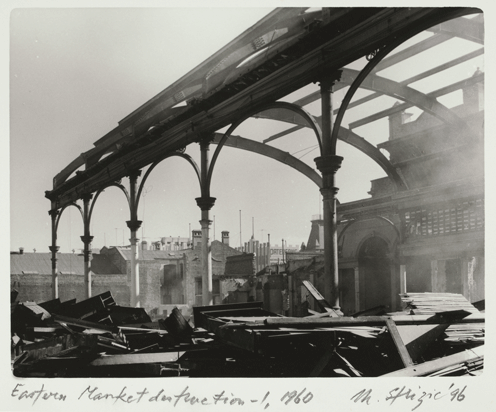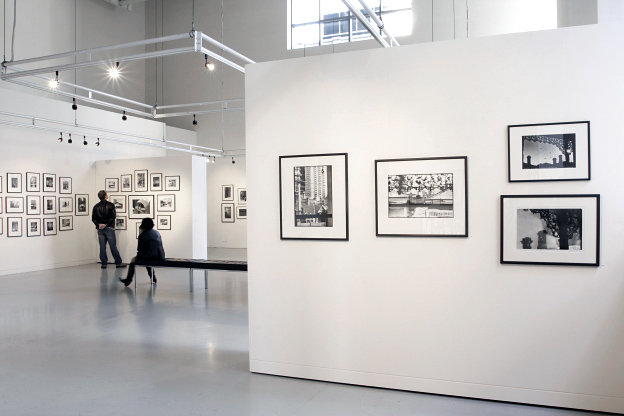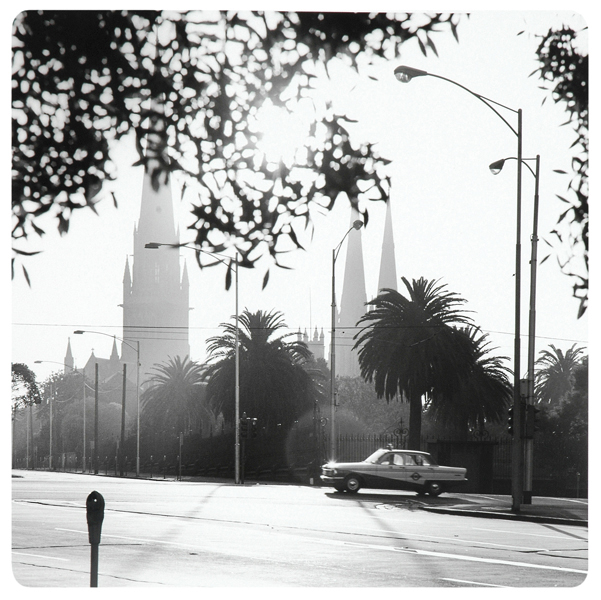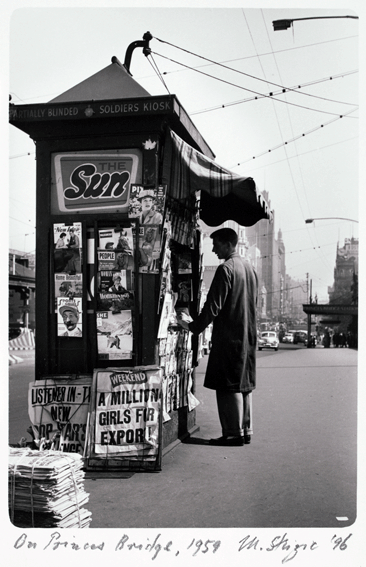March 2020
Unknown photographer (Australian)
Untitled (Flinders Street railway station)
1946-1947
Medium format negative
Collection of Nicholas Henderson
Another mountain of work scanning and cleaning 50 of these 2 1/4″ square (6 x 6 cm) medium format black and white negatives which come from the collection of my friend Nick Henderson. In Part 2 of the posting the family travel to Melbourne, Colac and Tasmania. The photographs of postwar Melbourne are fascinating. There are also pictures of mining works, a speedcar racer, picnic, pub, dogs, ballerinas, actors, children and some stunning, Frank Hurley-esque photographs of Sydney Harbour Bridge.
The photographs seem as though from another world. The Pacific Highway in North Sydney is almost deserted of traffic. A fascinating set of four photographs are Road accident, hay truck, Albion Park, New South Wales. In the first photograph from a distance we observe that a hay truck has lost its load, possibly after rounding the corner from left at too fast a speed, the intersection marked in the road by a small metal bollard. Small children inspect the underside of the truck while a boy on a bike rides to join them. What strikes one is the openness of the scene, the lack of other cars, and the spareness of the landscape, with only the “milk bar” with the Peters ice cream sign showing any sign of commerce. In the second image the photographer has moved around to the front side of the truck which tilts at a crazy angle. Two forty-gallon oil drums, possibly from the truck, have been placed upright on the road while bales of hay little the bitumen. In the background a petrol station advertises PLUME, Mobiloil, and Atlantic tyres(?) and on the right we can make out the Albion Park Hotel and the intersection around which the truck came.
In the third image which again shows the underside of the truck men have joined the scene, talking to presumably the shirtless truck driver in peaked cap, sheepishly standing among the twisted axles and staring at the camera. To the left two shoeless boys observe the scene. In the last photograph of the front of the truck we see kids sitting on the hay bails posing for the camera, while at far right the shirtless truck driver may be in conversation with others. What a glorious sequence of Walker Evans type social documentary photography… a brief context, an accident, a shooting star in the timeline of the galaxy.
My two favourite photographs in the posting: the almost solarised image of the Convict-built church at Port Arthur convict colony ruins; but more especially Number 42 tram going to Mont Albert. This photograph should become a classic in the annals of Australian photography. In one dynamic image the photographer has captured the hustle and bustle of postwar Melbourne – the women striding purposefully towards us, the Silver Top taxi cresting the rise at speed, the number 42 tram to Mont Albert kicking up dust from the tracks, the shadows, the gothic buildings, the towers behind and the vanishing point. A superlative image.
Hopefully there will be part 3 of this series when I get chance to scan some more negatives. In the meantime you can view Part 1 and these images. Enjoy!
Dr Marcus Bunyan
Many thankx to Nick Henderson for allowing me to publish the photographs in the posting. All photographs collection of Nick Henderson. Please click on the photographs for a larger version of the image.
Unknown photographer (Australian)
Untitled (Y.M.C.A, City Road, South Melbourne)
1946-1947
Medium format negative
Collection of Nicholas Henderson
Unknown photographer (Australian)
Untitled (Collins Street, Melbourne looking west from just above the Swanston Street intersection, Town Hall on the right, and then the Manchester Unity building across Swanston Street, probably taken from in front of the Regent Theatre)
1946-1947
Medium format negative
Collection of Nicholas Henderson
Unknown photographer (Australian)
Untitled (Looking at Flinders Street railway station on Elizabeth Street, Melbourne)
1946-1947
Medium format negative
Collection of Nicholas Henderson
Unknown photographer (Australian)
Untitled (Centreway Building on Collins Street, 259-263 Collins Street)
1946-1947
Medium format negative
Collection of Nicholas Henderson
Unknown photographer (Australian)
Untitled (Melbourne street)
1946-1947
Medium format negative
Collection of Nicholas Henderson
Unknown photographer (Australian)
Untitled (A. C. Goode House at 389-399 Collins) (the Gothic building at right)
1946-1947
Medium format negative
Collection of Nicholas Henderson
Unknown photographer (Australian)
Untitled (Russell Street taken from near Collins Street)
1946-1947
Medium format negative
Collection of Nicholas Henderson
Russell Street with police radio tower viewed from Collins street. American 1930’s car’s that where popular then, Dodge, Chevy, Lincoln & Fords! Yellow cab at left, and the cars are facing the same way both sides of the road. The Holden Motor Company built Buick, Chevy & Pontiac from “CKD” kits from the USA. Parking in the middle of the road (so we are not seeing the other side of the road).
Unknown photographer (Australian)
Untitled (Exhibition Street, looking from Collins Street, down past Flinders Lane)
1946-1947
Medium format negative
Collection of Nicholas Henderson
Unknown photographer (Australian)
Untitled (Collins Street looking up towards Old Treasury Building)
1946-1947
Medium format negative
Collection of Nicholas Henderson
Unknown photographer (Australian)
Untitled (Number 42 tram going to Mont Albert)
1946-1947
Medium format negative
Collection of Nicholas Henderson
Photograph taken where – Collins and Swanston Street? The lady is walking towards or just beyond the Melbourne Town Hall, the tram is on the other side of the road going the opposite way towards Mont Albert. In the centre background is the APA Tower and in front of it is the Mutual Life and Citizens Assurance Co (MLC) building. In the far distance is the Federal Hotel and Coffee Palace. Silver Top Pontiac Taxi (1937) slippery leather seats! Front bench seats with full length grab bar too hold on when cornering! (centre of image).
Many thankx to James Nolen for help identifying this image.
Unknown photographer (Australian)
Untitled (St Paul’s Cathedral, Melbourne looking from Flinders Street railway station)
1946-1947
Medium format negative
Collection of Nicholas Henderson
Unknown photographer (Australian)
Untitled (Princes Bridge, Melbourne on the Yarra River with Flinders Street railway station to the right)
1946-1947
Medium format negative
Collection of Nicholas Henderson
Unknown photographer (Australian)
Untitled (Seagulls, rowing sheds on the Yarra River, Melbourne)
1946-1947
Medium format negative
Collection of Nicholas Henderson
Unknown photographer (Australian)
Untitled (Bill Edwards speedcar, Victoria)
1946-1947
Medium format negative
Collection of Nicholas Henderson
Unknown photographer (Australian)
Untitled (Bill Edwards speedcar, Victoria)
1946-1947
Medium format negative
Collection of Nicholas Henderson
Unknown photographer (Australian)
Untitled (Union Club Hotel, Colac)
1946-1947
Medium format negative
Collection of Nicholas Henderson
Union Club Hotel, Colac
2010
Wikimedia Commons
Creative Commons Attribution-Share Alike 3.0 Unported
Unknown photographer (Australian)
Untitled (Picnic, family and car)
1946-1947
Medium format negative
Collection of Nicholas Henderson
Unknown photographer (Australian)
Untitled (Two women and two girls)
1946-1947
Medium format negative
Collection of Nicholas Henderson
Unknown photographer (Australian)
Untitled (Girl)
1946-1947
Medium format negative
Collection of Nicholas Henderson
Unknown photographer (Australian)
Untitled (Girl)
1946-1947
Medium format negative
Collection of Nicholas Henderson
Unknown photographer (Australian)
Untitled (Two lads and two children)
1946-1947
Medium format negative
Collection of Nicholas Henderson
Unknown photographer (Australian)
Untitled (Three dogs)
1946-1947
Medium format negative
Collection of Nicholas Henderson
Unknown photographer (Australian)
Untitled (Port Arthur convict colony ruins, Tasmania)
1946-1947
Medium format negative
Collection of Nicholas Henderson
Unknown photographer (Australian)
Untitled (Port Arthur convict colony ruins, Tasmania)
1946-1947
Medium format negative
Collection of Nicholas Henderson
Unknown photographer (Australian)
Untitled (Port Arthur convict colony ruins, Tasmania)
1946-1947
Medium format negative
Collection of Nicholas Henderson
Unknown photographer (Australian)
Untitled (Convict-built church at Port Arthur convict colony ruins, Tasmania)
1946-1947
Medium format negative
Collection of Nicholas Henderson
Unknown photographer (Australian)
Untitled (Pirates Bay Lookout, Tasmania)
1946-1947
Medium format negative
Collection of Nicholas Henderson
One of the Tasman Peninsula’s finest coastal lookouts is actually on the Forestier Peninsula, high on the hillsides above the Tesselated Pavement. Pirates Bay Lookout gives panoramic views down the east coast of Tasmania Peninsula and overs spectacular vistas towards Cape Hauy and Cape Pillar, which are both visible on a clear day. The lookout is on Pirates Bay Drive, the turnoff to the left off Tasman Highway being around 2 km before reaching Eaglehawk Neck when approaching from Dunalley. The lookout can also be accessed from Eaglehawk Neck. Simply take the Scenic drive past the Lufra Hotel.
Text from the Our Tasmania website [Online] Cited 29/03/2020
Pirates Bay Lookout, Tasmania
2009
Wikimedia Commons
Creative Commons Attribution-Share Alike 2.0 Generic
Unknown photographer (Australian)
Untitled (Men and shark) (location unknown)
1946-1947
Medium format negative
Collection of Nicholas Henderson
Unknown photographer (Australian)
Untitled (Mining landscape) (location unknown)
1946-1947
Medium format negative
Collection of Nicholas Henderson
Unknown photographer (Australian)
Untitled (Mining landscape) (location unknown)
1946-1947
Medium format negative
Collection of Nicholas Henderson
Unknown photographer (Australian)
Untitled (Mining landscape) (location unknown)
1946-1947
Medium format negative
Collection of Nicholas Henderson
Unknown photographer (Australian)
Untitled (Three dogs)
1946-1947
Medium format negative
Collection of Nicholas Henderson
Unknown photographer (Australian)
Untitled (Two dogs)
1946-1947
Medium format negative
Collection of Nicholas Henderson
Unknown photographer (Australian)
Untitled (Smiling girl with pigtails)
1946-1947
Medium format negative
Collection of Nicholas Henderson
Unknown photographer (Australian)
Untitled (Two ballerinas)
1946-1947
Medium format negative
Collection of Nicholas Henderson
Unknown photographer (Australian)
Untitled (Man and ballerina)
1946-1947
Medium format negative
Collection of Nicholas Henderson
Unknown photographer (Australian)
Untitled (Women in gown)
1946-1947
Medium format negative
Collection of Nicholas Henderson
Unknown photographer (Australian)
Untitled (Three girls)
1946-1947
Medium format negative
Collection of Nicholas Henderson
Unknown photographer (Australian)
Untitled (Two women, a man and a dog)
1946-1947
Medium format negative
Collection of Nicholas Henderson
Unknown photographer (Australian)
Untitled (Road accident, hay truck, Albion Park, New South Wales)
1946-1947
Medium format negative
Collection of Nicholas Henderson
Unknown photographer (Australian)
Untitled (Road accident, hay truck, Albion Park, New South Wales)
1946-1947
Medium format negative
Collection of Nicholas Henderson
Unknown photographer (Australian)
Untitled (Road accident, hay truck, Albion Park, New South Wales)
1946-1947
Medium format negative
Collection of Nicholas Henderson
Unknown photographer (Australian)
Untitled (Road accident, hay truck, Albion Park, New South Wales)
1946-1947
Medium format negative
Collection of Nicholas Henderson
Unknown photographer (Australian)
Untitled (Bridgeview Motors, 267 Pacific Highway, North Sydney with Sydney Harbour Bridge in the background)
1946-1947
Medium format negative
Collection of Nicholas Henderson
Unknown photographer (Australian)
Untitled (Lavender street, Lavender Bay looking towards the Sydney Harbour Bridge)
1946-1947
Medium format negative
Collection of Nicholas Henderson
Unknown photographer (Australian)
Untitled (Dawes Point ferry, under the Sydney Harbour Bridge looking to Fort Denison)
1946-1947
Medium format negative
Collection of Nicholas Henderson
Unknown photographer (Australian)
Untitled (Sydney Harbour Bridge, south looking north showing the North Sydney Olympic Pool in the background left)
1946-1947
Medium format negative
Collection of Nicholas Henderson
The North Sydney Olympic Pool is a swimming and exercise complex located adjacent to Sydney Harbour at Milsons Point in North Sydney between the Sydney Harbour Bridge and Luna Park. Designed by architects Rudder & Grout in the Inter-War Free Classical style with art deco-style decorations, the Olympic-sized outdoor pool was built on part of the Dorman Long workshops site following the completion of the Harbour Bridge. The pool opened 4 April 1936 and hosted the swimming and diving events for the 1938 Empire Games.
Text from the Wikipedia website
Unknown photographer (Australian)
Untitled (Sydney Harbour Bridge, north looking south showing DC current power station stack to the left)
1946-1947
Medium format negative
Collection of Nicholas Henderson
Unknown photographer (Australian)
Untitled (Under the Sydney Harbour Bridge, north looking south showing DC current power station stack to the left)
1946-1947
Medium format negative
Collection of Nicholas Henderson































































































You must be logged in to post a comment.